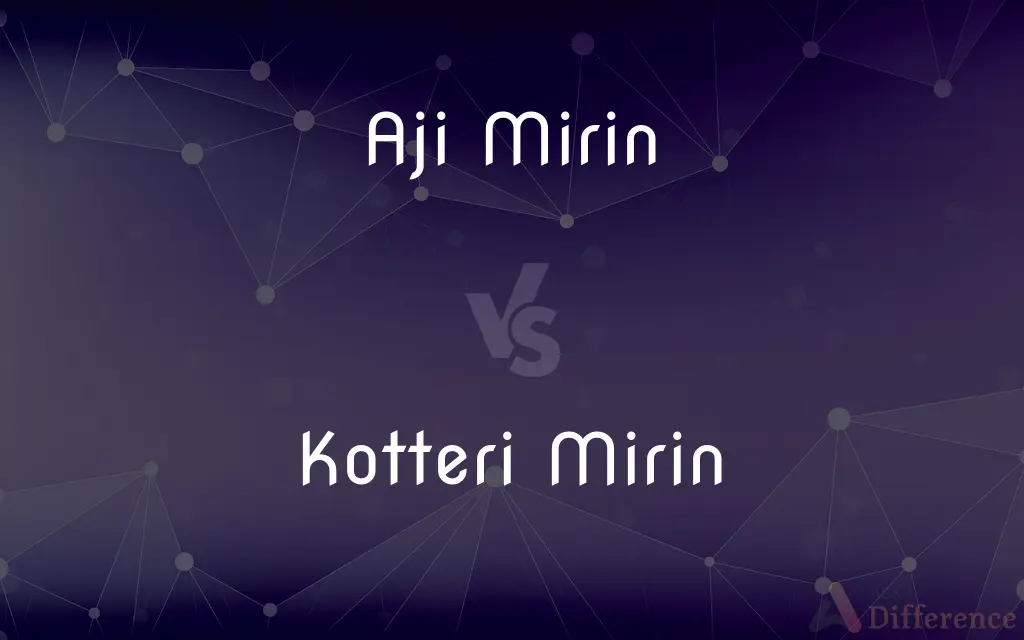Aji Mirin vs. Kotteri Mirin — What's the Difference?
By Tayyaba Rehman — Published on January 29, 2024
Aji Mirin is a type of sweet rice wine with a light flavor used as a seasoning in Japanese cooking, while Kotteri Mirin is a thicker, sweeter variety with a more intense flavor.

Difference Between Aji Mirin and Kotteri Mirin
Table of Contents
ADVERTISEMENT
Key Differences
Aji Mirin, often referred to as "taste mirin," is a type of rice wine used in Japanese cuisine. It is similar to sake but has a lower alcohol content and a higher sugar content, making it sweet and mildly flavored. Kotteri Mirin, on the other hand, is known as "thick mirin." It has a denser consistency and a richer sweetness compared to Aji Mirin, making it more potent in both taste and texture.
In terms of composition, Aji Mirin is typically made with a mix of glutinous rice, rice koji (mold), and distilled alcohol. This combination results in a light, sweet liquid that enhances the flavor of dishes without overpowering them. Kotteri Mirin, meanwhile, is often made through a longer brewing process, allowing it to develop a deeper sweetness and thicker texture, which adds a rich glaze to dishes.
Aji Mirin is commonly used as a versatile seasoning in Japanese cooking, adding a mild sweetness to a wide range of dishes, from teriyaki to soups and marinades. Its lightness makes it suitable for everyday cooking. Kotteri Mirin is used in dishes where a pronounced sweetness and thicker glaze are desired, such as in certain grilled dishes or glazes where its more robust flavor profile is beneficial.
When it comes to availability and use, Aji Mirin is more commonly found in stores outside Japan and is often used as a substitute for traditional mirin. It’s a staple in many Japanese kitchens due to its versatility. Kotteri Mirin, being thicker and sweeter, is less commonly used but is preferred in specific recipes that require its unique characteristics.
Nutritionally, both Aji Mirin and Kotteri Mirin are high in sugar, but Kotteri Mirin may have a higher sugar content due to its thicker consistency and richer flavor. Both types of mirin can add a subtle sweetness to dishes, but Kotteri Mirin’s stronger flavor makes it more suitable for dishes where a pronounced mirin taste is desired.
ADVERTISEMENT
Comparison Chart
Flavor
Light and mildly sweet
Richer and sweeter
Consistency
Thinner, more liquid
Thicker, syrup-like
Common Usage
Versatile for many dishes
Specific for rich glazes
Brewing Process
Shorter, with added alcohol
Longer, more natural fermentation
Sweetness Level
Moderately sweet
Very sweet
Compare with Definitions
Aji Mirin
Aji Mirin is lighter than traditional mirin.
For a lighter glaze, he used Aji Mirin in the recipe.
Kotteri Mirin
Kotteri Mirin undergoes a longer brewing process.
The depth of flavor in Kotteri Mirin comes from its extended fermentation.
Aji Mirin
Often used as an all-purpose cooking wine in Japanese cuisine.
Aji Mirin was her go-to seasoning for enhancing umami in soups.
Kotteri Mirin
Kotteri Mirin is a thick, sweet variety of Japanese cooking wine.
Kotteri Mirin added a rich sweetness to the grilled dish.
Aji Mirin
Aji Mirin is a common substitute for true mirin.
Lacking traditional mirin, she opted for Aji Mirin in her dish.
Kotteri Mirin
It is used for dishes requiring a pronounced mirin flavor.
For a more intense glaze, he chose Kotteri Mirin.
Aji Mirin
Aji Mirin is a sweet Japanese cooking wine with a mild flavor.
She added Aji Mirin to the sauce to give it a subtle sweetness.
Kotteri Mirin
Kotteri Mirin has a syrup-like consistency.
The Kotteri Mirin gave the sauce a thicker texture.
Aji Mirin
It's a versatile seasoning used in various Japanese dishes.
Aji Mirin is a key ingredient in her teriyaki marinade.
Kotteri Mirin
Preferred in recipes that need a richer, sweeter taste.
She used Kotteri Mirin in her recipe for a deeper flavor profile.
Common Curiosities
Can Aji Mirin be used in place of Kotteri Mirin?
Yes, but it will give a lighter flavor and less sweetness compared to Kotteri Mirin.
How does Kotteri Mirin differ in taste from Aji Mirin?
Kotteri Mirin is richer and sweeter than the milder Aji Mirin.
Is Kotteri Mirin used for everyday cooking?
Kotteri Mirin is less common for everyday cooking and more for specific dishes needing a rich glaze.
What is Aji Mirin primarily used for?
Aji Mirin is used as a seasoning to add mild sweetness to various Japanese dishes.
Can I substitute Aji Mirin for regular mirin?
Yes, Aji Mirin is a common substitute for traditional mirin.
What type of dishes is Aji Mirin best suited for?
Aji Mirin is suited for a wide range of dishes like soups, marinades, and teriyaki.
What makes Kotteri Mirin sweet?
Its sweetness comes from a longer natural fermentation process.
Can Kotteri Mirin be used in marinades?
Yes, especially in marinades where a richer flavor is desired.
How should Aji Mirin be stored?
Store Aji Mirin in a cool, dark place, ideally in the refrigerator after opening.
Does the flavor of Kotteri Mirin vary from brand to brand?
Yes, different brands may have slight variations in flavor and sweetness.
Is Aji Mirin suitable for vegetarian dishes?
Yes, it can be used in vegetarian dishes to add a touch of sweetness.
Is Kotteri Mirin thicker than Aji Mirin?
Yes, Kotteri Mirin has a thicker, syrup-like consistency.
Is Aji Mirin used in dressings and sauces?
Yes, its mild sweetness is ideal for dressings and sauces.
Is Kotteri Mirin a good choice for glazing?
Yes, its thick consistency and rich flavor make it ideal for glazes.
Does Aji Mirin contain alcohol?
Yes, but it has a lower alcohol content compared to traditional mirin.
Share Your Discovery

Previous Comparison
Mormons vs. LDS
Next Comparison
Fryer Chicken vs. Roaster ChickenAuthor Spotlight
Written by
Tayyaba RehmanTayyaba Rehman is a distinguished writer, currently serving as a primary contributor to askdifference.com. As a researcher in semantics and etymology, Tayyaba's passion for the complexity of languages and their distinctions has found a perfect home on the platform. Tayyaba delves into the intricacies of language, distinguishing between commonly confused words and phrases, thereby providing clarity for readers worldwide.













































